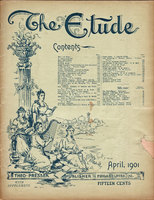It was once said of Mark Hopkins that he could make a university out of a log with himself at one end and a pupil at the other. But the average teacher, and many who think themselves far above the average, need the best materials possible to work with. What is the material used in a singer’s training? Breathing exercises, voice-placing exercises of various kinds, and, from the musical side, scale-work, drill on various figures and passage-work, embellishments, skips, all calculated to develop flexibility and purity of intonation, solfeggi, and songs, mostly the latter.
And now a few words in regard to the songs most in use to-day. Modern composition and modern song- writing, particularly, are largely based on principles which have but little relation or foundation in the solfeggi, the etudes or study pieces of a musical character, available for the needs of the voice-trainer. These latter are usually melodious, but the product of minds steeped in the principles of the old Italian art of singing, which is based on purely sensuous conditions,—beauty of tone, a smooth-flowing legato, and great agility,—while the songs which the best singers of to-day are singing, which the best composers write, and which a multitude of others try to write and to sing, are the outcome of the changes embodied in the vocal writing of Richard Wagner and in the compositions of the romantic school before him: songs which introduce vocal effects and color-contrasts that are produced by entirely different means.
As a result, the work of the finished singer of to-day does not hang closely together with the fundamental drill of the pupil in singing. It is possible for a singer who has been thoroughly grounded in the principles of the bel canto to be the perfect artist in the most advanced modern songs and vocal writing,—a number have demonstrated this,—but it is not because the previous work inevitably fitted him for it. It may have helped him, but did not of itself make him a great singer of modern songs.
May it not be that there is somewhat of a gap in the system of vocal training? Certainly it is a fact that vocal training has not been so well graded as the materials for piano-study. Teaching pieces are carefully graded and written to help the pupil over certain points of technical difficulty. There was a time when the work of technical advancement was considered possible only by means of a number of dry exercises, conceived with little or no reference to musical quality. To-day the demand is for pieces which shall reach the same end, but which must be distinctly musical in character. If a pupil is to become truly musical, what he studies must be in accordance with the ideal he cherishes. Of course, certain technical facility can be secured by pure scale-work, but with this, as said be fore, is associated etude study and drill on pieces that are thoroughly musical.
Why should not the teacher of singing be able to give to his pupil songs that conform to the principles of the modern art-song, but without the more difficult and subtle manifestations of those principles? The easy pieces used as “first songs” hardly reach this standard; in fact, many songs cannot be graded. It is nearly always possible to find in those available for use during the first season’s lessons a number of pas sages that are much more difficult than the other parts of the same songs.
If young singers are to sing the modern dramatic songs, then they should have a technical drill that shall prepare them for it. Why is it not possible to have and to use vocalizes and solfeggi that contain passages of an emotional quality? There is such a thing as character in a solfeggi, passages that will admit of variety in tone-color, phrasing, and attack, just as truly as that such passages exist in music for the orchestra, the violin, and the piano. Text is not necessary for an emotional plan. It can be the outgrowth of the music itself.
Hence one remedy for the trouble is that teachers shall use the best judgment in selecting solfeggi, and then adapt them to a style of treatment that will prepare for the modern dramatic, emotional song. If such solfeggi do not exist, composers should be called upon to furnish them, particularly composer-teachers and singers; so also should we have songs that are more uniformly graded, that are truly art-songs, sound in principle, pleasing in Musical quality, and not too difficult in technical demands.—W. J. Baltzell.



